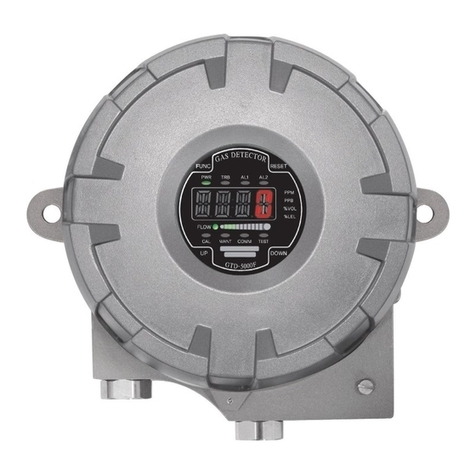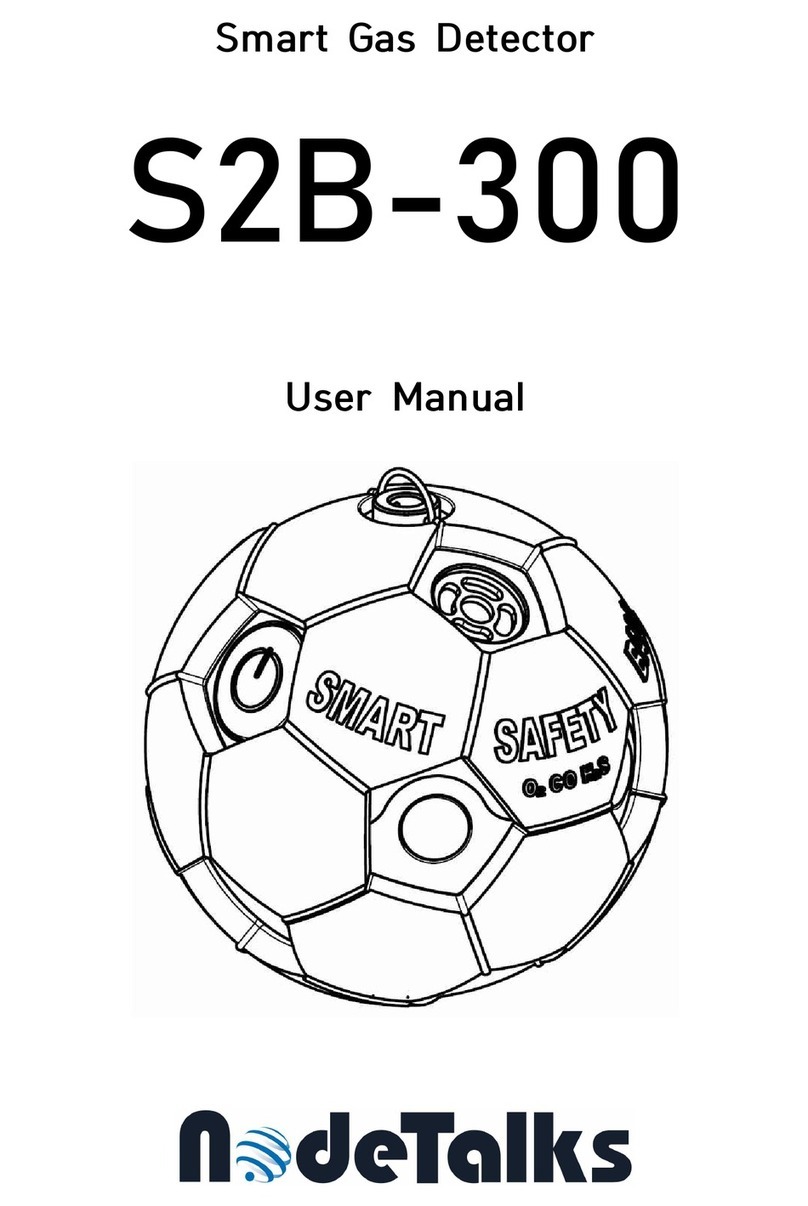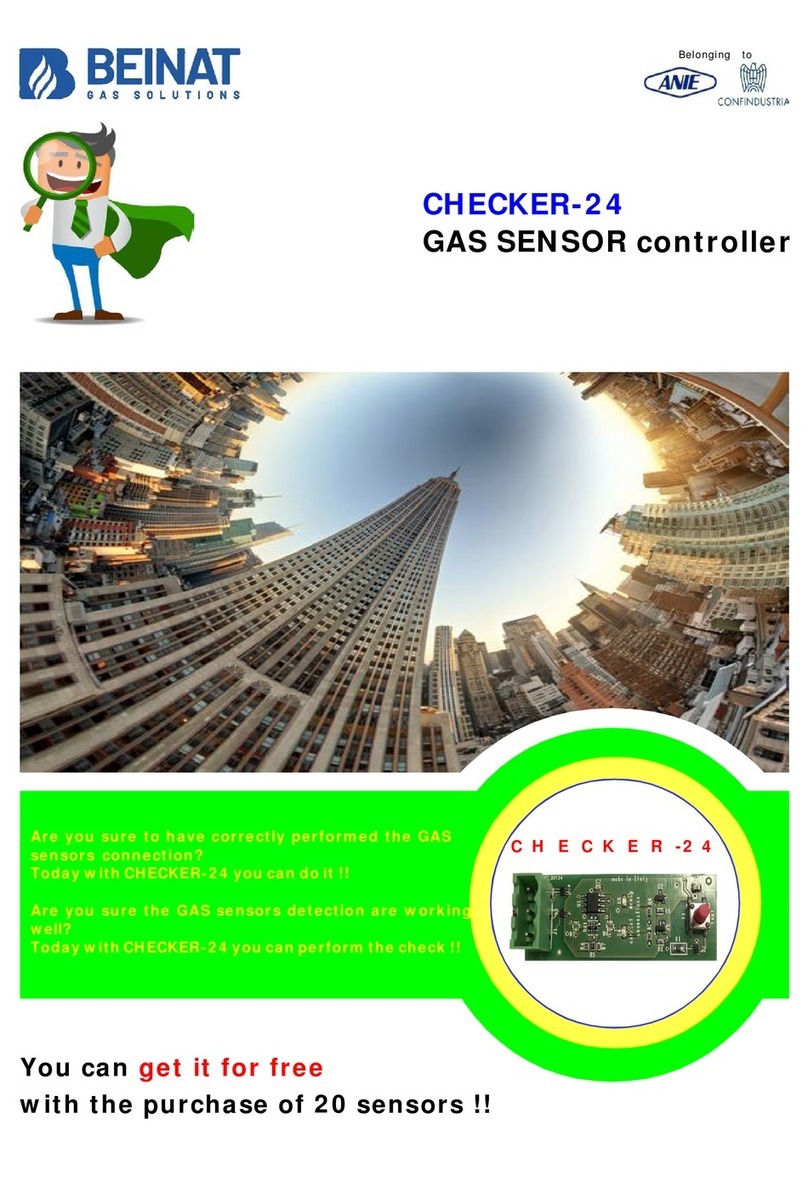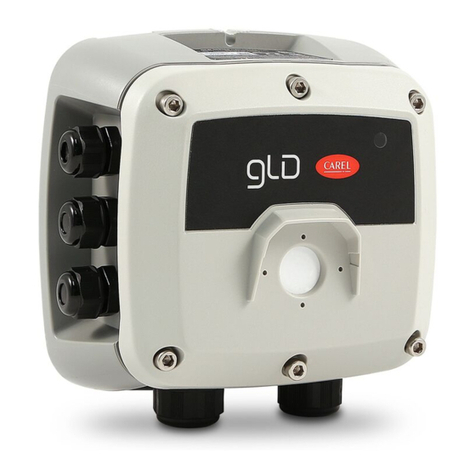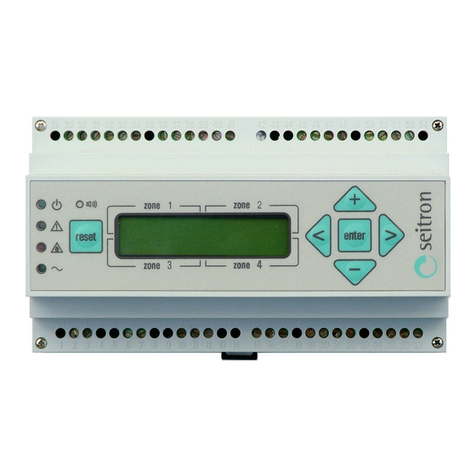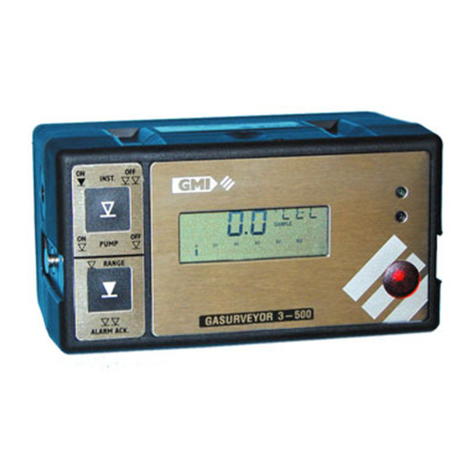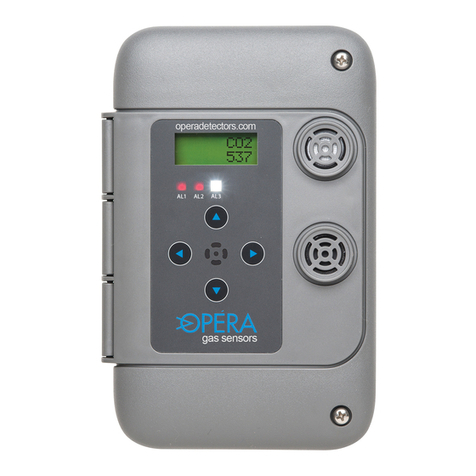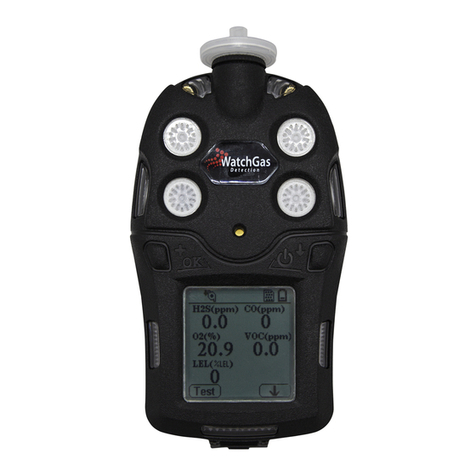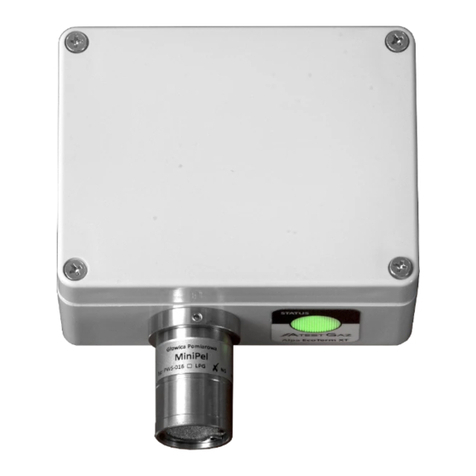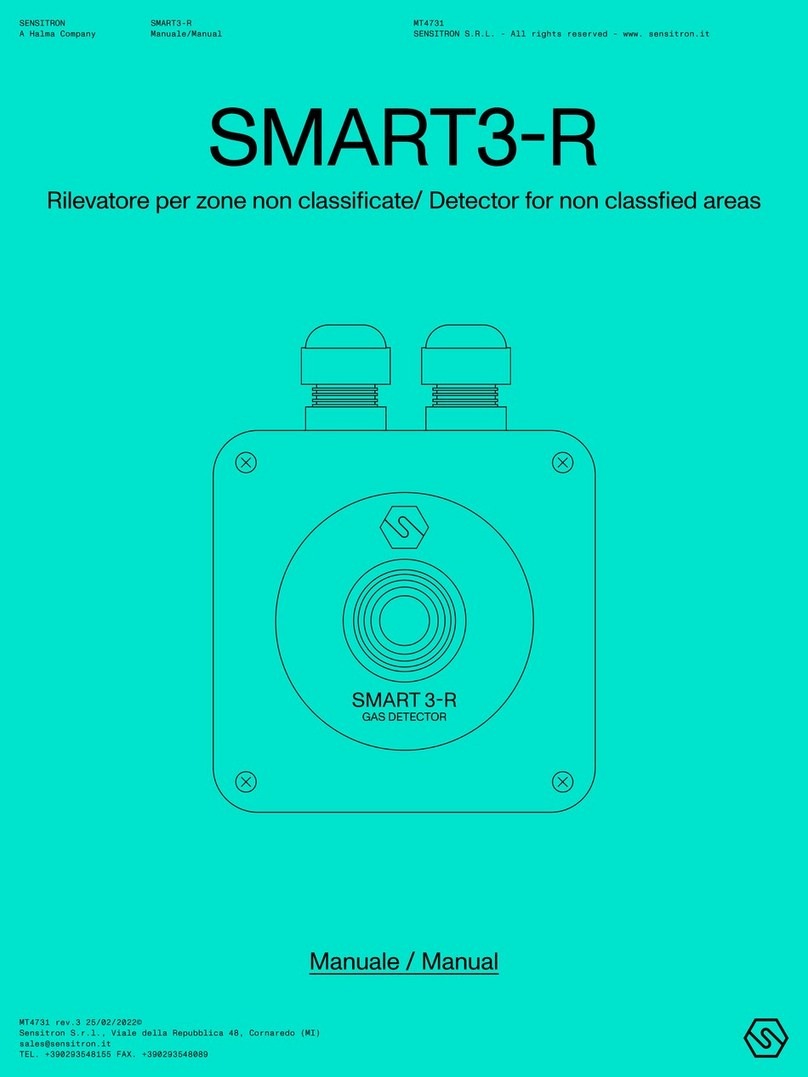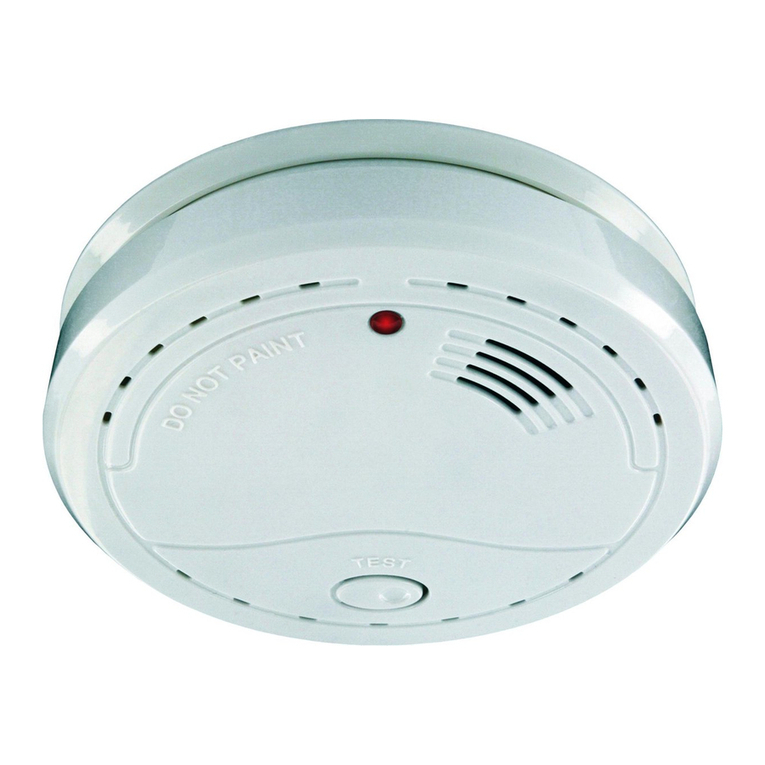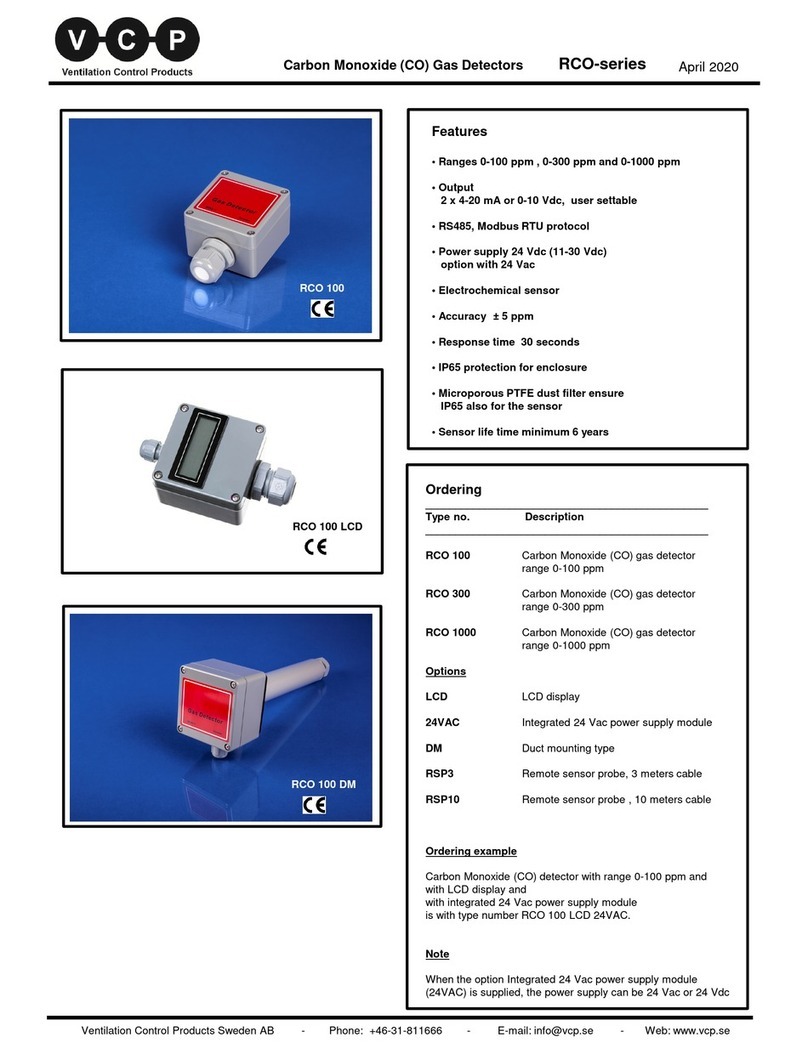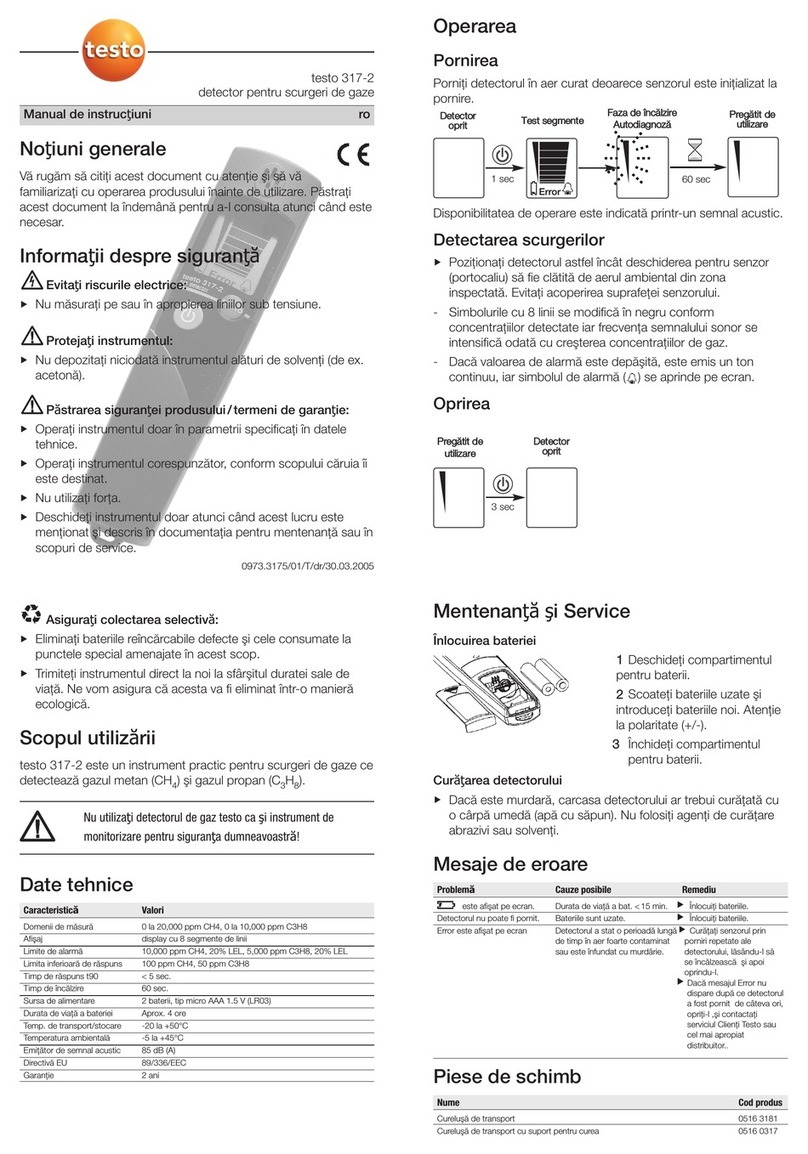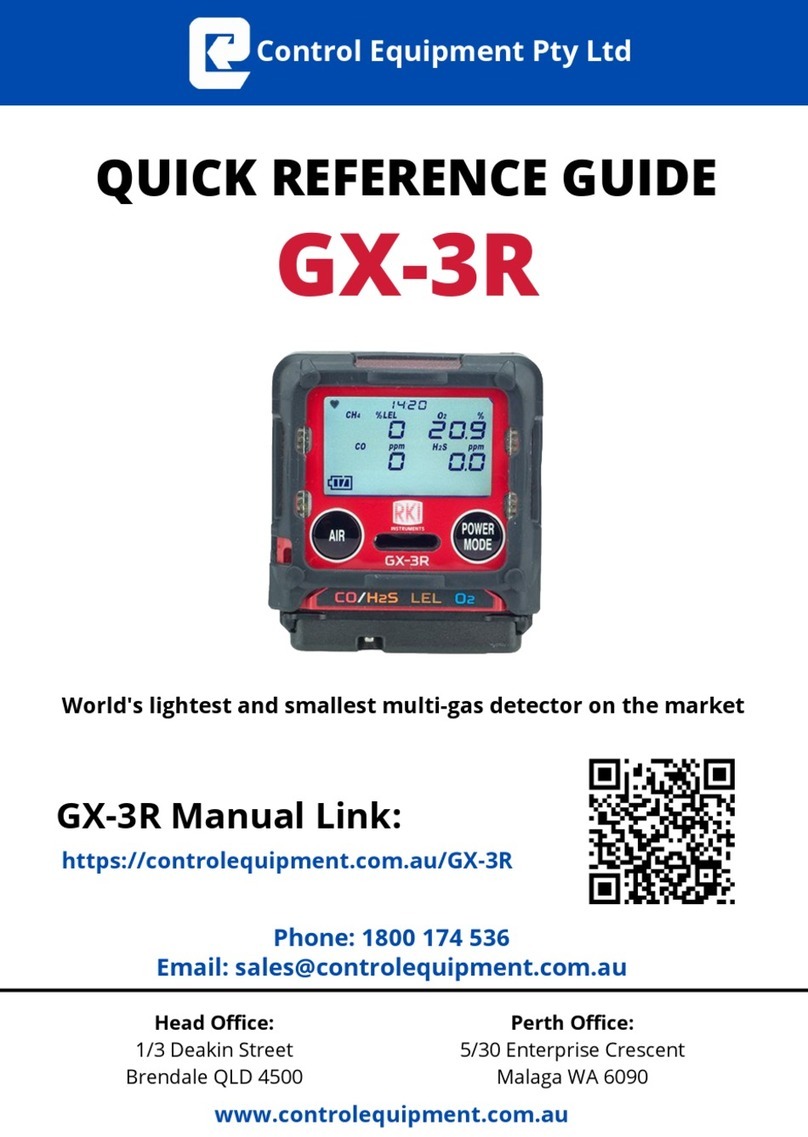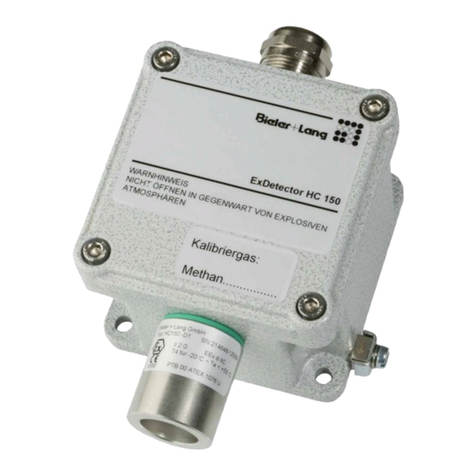Sri TCD User manual

DETECTORS
Thermal Conductivity Detector - TCD
Overview
The Thermal Conductivity Detector (TCD) is the most universal detector available. Depending on the
compound, the TCD responds with a detection range of 0.01% to 100% (100-1,000,000ppm). The SRI
TCD consists of four filaments housed in a stainless steel detector block. The TCD detector block is installed
in its own thermostatically-controlled oven for stability. The TCD oven is mounted on the right rear of the
column oven. The TCD filament control switch and the bridge terminal block to which the filament leads are
connected are located to the immediate right of the detector oven. Since the four TCD filaments can be
damaged or destroyed if energized in the absence of carrier gas flow, a TCD filament protection circuit is
provided in all TCD-equipped SRI GCs.
TCD Detector on an SRI GC TCD Detector on an SRI GC with
detector cover and top/front
insulation removed for clarity
Color-coded TCD
filament leads are
connected to the
bridge terminal block
TCD filament current
control switch
TCD detector oven setpoint (trimpot)
TCD Detector
(paired with an
FID detector) on
an SRI 8610 GC
TCD Detector on
an SRI 310 GC
Color-coded
filament leads
Insulation
TCD detector
body
TCD detector
housing

One of four TCD filaments TCD filament bridge
red/green
black/green
red/blue
black/blue
RS
SR
DETECTORS
Thermal Conductivity Detector - TCD
Theory of Operation
The TCD detector measures the difference in thermal conductivity in the carrier gas flow and the analyte
peaks. Every compound possesses some degree of thermal conductivity, and may therefore be measured with
a TCD detector. Due to its high thermal conductivity and safety, helium carrier is most often used with TCD
detectors. However, other gases may be used such as nitrogen, argon, or hydrogen.
The Wheatstone Bridge circuit
design in the SRI TCD uses four
general-purpose tungsten-rhenium filaments for sample analysis. Two of
the filaments are exposed to the sample-laden carrier gas flow and provide
the actual chromatographic signal. The other two filaments are provided
with clean carrier flow, enabling them to be used as a baseline reference
signal. When the effluent from the column flows over the two sample
stream filaments, the bridge current is
unbalanced with respect to the
reference signal. This deflection is
translated into an analog signal which
is sent to the data system for analysis.
The four pairs of filament leads are
color-coded in two-color units; each
color is used on two different leads. All
eight wires are connected to the bridge
current supply via four setscrew-type
terminal connectors on the top control
panel of the GC. Silkscreened labelling
on the chassis indicates which color
wire connects to each terminal.
The TCD detector block is divided
into two cells containing two filaments each. One cell holds the reference pair while the other cell holds the
sample pair. All four TCD filaments are physically identical except for their color-coding. The carrier gas is
plumbed so that is exits the Electronic Pressure Controller module, flows through the polishing filter, through
the reference side of the TCD bridge, then through the injection port to the column, and from the column to the
sample side of the TCD bridge. After the flow passes through the sample cell, it is directed back out of the
TCD oven and into the column oven through the TCD detector outlet, where it may be routed to a subsequent
detector or to vent. All four TCD detector inlet/outlet tubes are 1/16” stainless steel.
Simplification of filament interconnection
Color-coded
filament leads
Reference gas in
REFERENCE
SAMPLE
Sample gas in
REFERENCE
SAMPLE
Red
Green
Red
Blue
Green
Black
Blue
Black
TCD carrier gas flow diagram

Expected Performance
Carrier: Helium @ 10mL/min
TCD gain = LOW
TCD temp = 100oC
Temperature program:
Initial Hold Ramp Final
80oC 15.00 0.00 80oC
Results:
Component Retention Area
Oxygen 1.633 19.7500
N2 2.150 121.0880
Methane 3.033 563.6130
Ethane 7.550 128.2185
CO2 9.983 11.9860
Propane 13.683 113.9220
Iso-Butane 18.150 69.4960
N-Butane 18.766 67.4460
Iso-Pentane 22.550 20.1490
N-Pentane 22.866 19.1560
Total: 1134.8245
Temperature program:
Initial Hold Ramp Final
40oC 5.00 10.00 220oC
220oC 16.00 0.00 220oC
Events:
Time Event
0.00 ZERO
0.050 G ON (valve inject)
6.00 G OFF
DETECTORS
Thermal Conductivity Detector - TCD
Sample: natural gas standard, 1mL sample loop Columns: 1m Molecular Sieve, 2m Silica Gel
Factory Test Run of a TCD-equipped SRI GC
TCD Noise Run
TCD noise averages 10µV frompeak to peak

Expected Performance
DETECTORS
Thermal Conductivity Detector - TCD
TCD Room Air Analysis
TCD Breath Analysis
Column: 3’ Silica Gel
Carrier: Helium at 10mL/min
Sample: 0.5cc room air,
direct injection
TCD current: LOW
TCD temperature: 100oC
Temperature Program:
Initial Hold Ramp Final
80oC 4.00 0.00 80oC
The CO2content of the room air analyzed is approximately 350ppm.
Column: 3’ Silica Gel
Carrier: Helium at 10mL/min
Sample: 0.5cc human breath,
direct injection
TCD current: LOW
TCD temperature: 100oC
Temperature Program:
Initial Hold Ramp Final
80oC 24.00 0.00 80oC
Results:
Component Retention Area
O2N20.700 1379.4740
CO22.700 61.9540
Total 1441.4280
Results:
Component Retention Area
O2N20.716 1021.3830
CO22.766 1.5060
Total 1022.8890

General Operating Procedure
1. Check to make sure that the TCD filament current is switched OFF. Plug in and turn on your GC. Allow
the TCD detector oven to reach temperature (100oC) and stabilize. With the “Display Select” switch in the
UP position, press on the TCD Temperature Actual button on the front control panel to read the TCD cell
temperature. The TCD oven block is set to 100oC at the factory, but is adjustable by turning the trimpot
with a small blade screwdriver while observing the TCD BLOCK setpoint temperature on the digital display.
The trimpot is located on the top edge of the GC’s front control panel, under the red lid.
2. All TCD-equipped SRI GCs are tested with a 1m, 1/8” stainless steel silica gel-packed column. The
carrier gas head pressure is preset at the factory to 10mL/min for this type and size column. Look on the
right side of the GC for the carrier pressure that correlates to a flow of 10mL/min. Because different
columns require different flow rates, the carrier head pressure may be adjusted by the user with the trimpot
above the “CARRIER 1” buttons.
3. Make sure that the setpoint and actual pressures are within 1psi.
4. Damage or destruction of the TCD filaments will occur if current is applied in the absence of flowing carrier
gas. ALWAYS verify that carrier gas can be detected exiting the TCD carrier gas outlet BEFORE energizing
the TCD filaments. The carrier gas outlet tube is located on the outside of the Column Oven on the same
side as the detector. Place the end of the tube in liquid and observe (a little spit on a finger can suffice). If
there are no bubbles exiting the tube, there is a flow problem. DO NOT turn on the TCD current if carrier
gas flow is not detectable. A filament protection circuit prevents filament damage if carrier gas pressure is
not detected at the GC, but it cannot prevent filament damage under all circumstances. Any lack of carrier
gas flow should be corrected before proceeding.
5. With the TCD filaments switched OFF, zero the data system signal. Switch the filaments to LOW. The
signal’s deflection should not be more than 5-10mV from zero for a brand-new TCD detector. Any more
than a 5-10mV deflection indicates partial or complete oxidation of the TCD filaments; more deflection
means more oxidation. Therefore, it is a good habit to use the data system signal to check the working
order of the TCD filaments.
6. In PeakSimple, set an isothermal column oven temperature ramp program as follows:
Initial Temp. Hold Ramp Final Temp.
80oC 7.00 0.00 80oC
7. Zero the data system signal (clicking on the Auto Zero button at the left edge of the
chromatogram window is one way to do it), then start the run (hit the computer
keyboard spacebar or hit the “RUN” button on the GC).
8. Inject sample. Injection volumes of 0.5mL for gas and 1µL for liquid is recommended
to prolong TCD filament life.
Auto Zero
button
DETECTORS
Thermal Conductivity Detector - TCD

All TCD detectors are susceptible to filament damage or destruction if operated at high current in the
absence of carrier and/or reference gas flow. The filaments will incandesce and burn out if the carrier or
reference gas flow is interrupted due to a variety of possible factors such as a column break, inadvertent
column disconnection during column changes, removal of the septum nut for septum replacement, or when the
carrier gas cylinder runs dry during an analysis. The SRI TCD filament protection circuit is a current “cut-out”
circuit that monitors the column head pressure during GC operation. Under normal circumstances, there is no
reason for the column head pressure to drop below 3psi, with most columns operating at 8psi or above. When
the head pressure sensor located in the carrier gas flow path drops below 3psi, the protection circuit is activated,
and the current to the TCD filaments is interrupted immediately. A red LED on the GC’s front control panel
under “DETECTOR PARAMETERS” will light to indicate that the protection circuit has detected a gas
pressure loss and shut down the filament current. The cause of the protection circuit activation should be
immediately investigated and corrected. As an additional caution, use HIGH current only with helium or
hydrogen carrier gases. With nitrogen carrier, use LOW current only, or the filaments may be damaged. The
pressure at which the protection circuit activates is user adjustable with the trimpot on the top edge of the front
control panel, above the label reading “TCD PROTECT.”
TCD Filament Protection Circuit
1- Pressing the LOCAL SETPOINT button displays the filament cut-off setpoint value (factory set at 3psi) in
the bright red LED display in the upper right corner of the GC’s front control panel. If the carrier gas pressure
reaches or falls below this value, the filament current will immediately be interrupted.
2- Pressing the TOTAL SETPOINT button displays the carrier gas pressure present in the GC system. Under
normal operation, this value will be well above the 3psi cut-off setpoint.
3- The STATUS LED glows bright red only when the TCD protection circuit has been activated.
4- Pressing the ACTUAL button displays the voltage present across one half of the TCD bridge. A value of
3.5 to 4.5 volts is typical when using high current; low current will display 2.5-3.5 volts (note: the LED displays
4 volts as “400,” 3.5 as “350,” etc.). Any value lower than these indicates a potential problem in the TCD
detector bridge.
DETECTORS
Thermal Conductivity Detector - TCD
TCD protection circuit LED lit on an SRI
model 8610 GC front control panel
1-
2-
3-
4-
LED panel
displays control data
corresponding to
the button pressed
Bright red LED display
1-
2-
3-
4-
LOCAL SETPOINT button
TOTAL SETPOINT button
ACTUAL button
STATUS LED
The DISPLAY SELECT
switch allows the user
to choose between
displaying the control
zones using the buttons
or the column oven
temperature

Standard TCD filament with rubber O-ring gasket 8670-9120
High temperature TCD filament with copper gasket 8690-9123
TCD Troubleshooting
When the TCD fails to perform normally, review operating conditions to ensure
that carrier gas flow to the detector is unimpeded, and that the column oven
temperature, carrier gas flow rate, and carrier gas EPC pressure are all within the
desired operating parameters. If all conditions are properly met and the detector
continues to perform poorly or fails to perform at all, check the TCD filaments for
damage. The main diagnostic test is to measure the resistance of each filament using
the ohmeter function of a multimeter or volt-ohmeter (VOM). At room temperature,
the resistance of each filament should be 32-34 ohms. At 100oC, the filaments are
around 40 ohms each. If any filament is significantly different from the others, the
TCD bridge will be unbalanced, noisy and drifty. All eight filament wires must be
disconnected and tested. Since all the leads are bundled together as they exit the
TCD detector assembly, you may need to use the multimeter or VOM to determine
the actual pairs. It is normal for each filament to have a slightly different reading
within the appropriate operating range, so match the readings to determine the lead
pairs.
With the power turned off and the power cord unplugged from the electrical
outlet, raise the red lid to access the TCD detector. Exiting the right side of the
TCD detector oven is the bundle of 8 insulated, color-coded wires in pairs. Each
pair of wires represents one filament and is connected to the appropriately labeled
terminal for its paired colors. One filament has red/green, one red/blue, one black/
green, and one black/blue. The red/green and black/blue are the sample side
filaments, and the ones which typically deteriorate first. Remove the 8 wires from
the bridge terminal by loosening the retaining setscrews with a small blade screwdriver.
Measure the resistance across the filament leads using an ohmeter, making sure the
correct pair of colored wires is tested together for each filament. An infinite reading
is an indication that the filament is open, or burned out. If any of the filaments has a
significantly different resistance than the others (which should be in the ranges
mentioned above), it should be replaced. Replacement filaments, o-rings, and TCD
blocks with four new filaments are available from SRI. In addition to the standard
filaments, optional gold-plated filaments for improved corrosion resistance are also
available.
SRI TCD detector replacement parts
DETECTORS
Thermal Conductivity Detector - TCD
Many multimeters are
available; these two are
from Fluke Corporation:
USA: 1-800-44-FLUKE
EU: (31 40) 2 678 200
www.fluke.com
(filament part #s are also listed on the top of the TCD oven in your SRI GC)

Replacing the TCD Filaments
A. Standard TCD detector block access
1. With a small blade screwdriver, free the filament leads from the bridge terminal by loosening the
setscrews.
2. Remove the detector assembly cover by unscrewing the thumbscrew then sliding the cover off
toward the right-hand edge of the GC; gently remove the white insulation to reveal the detector block.
3. Disconnect the detector block gas inlets and outlets. The reference gas inlet is disconnected at the
polishing filter immediately behind the column oven. The reference gas outlet is disconnected inside
the column oven. Disconnect the sample gas inlet at the fitting on the column. The detector block
sample gas inlet tubing has a copper sheath for identification. The sample gas outlet is usually routed
out the right side of the column oven.
Exploded view of the standard TCD detector assembly
SRI TCD detectors are made to last a long time without ever replacing the filaments. However, any TCD
filaments that fail the diagnostic ohmeter test mentioned previously will have to be replaced. While they share
the same outer assembly, there are a few differences between the high temperature TCD detector block and
the standard TCD block. Both designs are discussed. All filaments are fragile; handle them with care. Have
colored ink pens, electrical tape, whatever you will use for color coding close at hand before you begin. It is
best to go slowly, color-coding then replacing each filament one at a time. IF YOU MIX UP THE FILAMENT
LEADS, YOUR TCD WILL NOT WORK!
DETECTORS
Thermal Conductivity Detector - TCD

(Standard TCD detector block access continued)
4. Cut the fiberglass tape wrapped around the detector block and peel it off. Unwrap and remove the
heater rope from the detector block (it is probably affixed to the thermocouple wires with more
fiberglass tape).
5. Disconnect the thermocouple by loosening the small philips head screw which holds it on the
detector block clamshell. Next, remove the clamshell by unscrewing the two small philips head screws
that hold its halves together. Gently remove the white insulation to reveal the detector block.
6. The TCD filaments are secured in the detector block by two plates, each of which is held in place
with three hexagonal head screws. Holding the detector block with one hand, use an Allen wrench to
unscrew and remove the hexagonal head screws from one of the filament securing plates. Then, slide
the filament securing plate off the filaments and leads. Set it securely aside.
7. Once the securing plate is removed, the filament and rubber O-ring that seals it can be gently pulled
out of the detector block cell. When replacing a filament, its rubber O-ring should also be replaced.
Check the lip of the detector block cell for fragments of the old O-ring and if any are present, remove
them as they will interfere with proper sealing of the cell. If you’re replacing one reference or sample
filament, replace the other at the same time. If you didn’t have fun disassembling the TCD detector
block, replace all the filaments while you have it open. It’s a good idea to remove then replace one
plate and corresponding pair of
filaments at a time to avoid mixing up
their connections.
8. To install a new filament, color-
code it the same as the filament you
are replacing, then slide it, leads first,
through the appropriate hole in the
filament securing plate. An existing or
replacement filament should occupy
the other hole. Place a new rubber
O-ring against the rim of the detector
block cell which will accept the new
filament. Place filament securing plate
and filaments against the detector block
with the filaments inside the detector
block cells. Replace and tighten the 3
hex-head screws. Repeat this process
on other side to replace the
corresponding filament.
9. Reverse your steps for TCD
detector reassembly. Steps 7-10 of
the high temperature TCD detector
block access instructions detail
reassembly of the inner clamshell and
outer detector housing.
Filament securing plate
Filament
Sample cell
Reference cell
Detector block
Rubber O-rings
Hexagonal head
screws
Insulated filament leads
Exploded view of the standard TCD detector block
Replacing the TCD Filaments continued
DETECTORS
Thermal Conductivity Detector - TCD

Replacing the TCD Filaments continued
B. High temperature TCD detector block access
The high temperature TCD assembly is the same as the standard: outer housing around an inner
clamshell case. The high temp detector block uses gland nuts and copper gaskets to secure the four
filaments in its two cells. Instead of the heater rope, it employs a heating cartridge, which is inside the
inner clamshell case with the detector block.
1. With a small blade screwdriver, disconnect the filament leads from the bridge terminal by loosening
the setscrews.
2. Remove the detector housing by unscrewing the thumbscrew then sliding the housing cover off
toward the right-hand edge of the GC. Gently remove the white insulation to reveal the detector
block.
3. Disconnect the detector block gas inlets and outlets. The reference gas inlet is disconnected at the
polishing filter immediately behind the column oven. The reference gas outlet is disconnected inside
the column oven. Disconnect the sample gas inlet at the fitting on the column. The detector block
sample gas inlet tubing has a copper sheath for identification. The sample gas outlet is usually routed
out the right side of the column oven. Once these three fittings are loosened and the detector block
tubing freed, gently pull the detector block away from the housing.
DETECTORS
Thermal Conductivity Detector - TCD
Exploded view of high temperature TCD detector block and inner clamshell
Copper gaskets
Gland nuts
Filaments
and leads
Detector block Installed/secured filaments
Half of inner clamshell case Half of inner clamshell case
Insulated
padding
Insulated
padding

Replacing the TCD Filaments continued
(High temperature TCD detector block access continued)
4. Open the inner clamshell case by unscrewing the two small philips head screws that hold the two
halves together. Gently remove the white insulation to access the detector block.
5. The filaments are held in place by gland nuts; loosen these nuts to
remove the filaments and copper gaskets. Color-code the new filament
the same as the one you are replacing (you can use colored marker
pens, electrical tape, etc.) before completely removing the old one.
Slide the gland nut off the existing filament, toward the ends of the
filament leads.
6. Put the new filament’s leads through the gland
nut. Slide the gland nut up the filament’s leads until it
rests against the base of the filament. Place the
copper gasket against the rim of the detector block
cell opening. Carefully insert the filament and gland
nut together into the cell opening. Tighten the gland
nut to secure the filament in the cell.
7. When you’re finished replacing filaments, place the re-assembled detector block
inside the inner clamshell with the insulation and heater cartridge. Make sure the gas
inlet and outlet tubes are running through the cut-outs in the clamshell. Secure the
clamshell with its two screws.
8. Reconnect the TCD detector gas inlets and outlets.
9. Replace the inner clamshell and its insulation inside the detector housing that is permanently mounted
on the column oven wall. Replace the housing cover and secure with its thumbscrew.
10. Reconnect the filament leads to the bridge current terminal block. Use the color guide labels on
the terminal block to insert the color-coded leads into the appropriate terminal.
Slide the gland nut
down and off to
remove the filament
DETECTORS
Thermal Conductivity Detector - TCD
Table of contents

